13 What Is Standard Argument Form?
Kirsten DeVries
A standard way of capturing the structure of an argument, or diagramming it, is by numbering the premises and conclusion. For example, the following represents another way to arrange the littering argument:
- Littering is harmful
- Litter is dangerous to animals
- Litter is dangerous to humans
This numbered list represents an argument that has been put into standard argument form. A more precise definition of an argument now emerges, employing the vocabulary that is specific to academic and rhetorical arguments. An argument is a set of statements, some of which (the premises: statements 2 and 3 above) attempt to provide a reason for thinking that some other statement (the conclusion: statement 1) is true.
Tip
Diagramming an argument can be helpful when trying to figure out your essay’s thesis. Because a thesis is an argument, putting the parts of an argument into standard form can help sort ideas. You can transform the numbered ideas into a cohesive sentence or two for your thesis once you are more certain what your argument parts are.
Figure 3.2 “Argument Diagram”
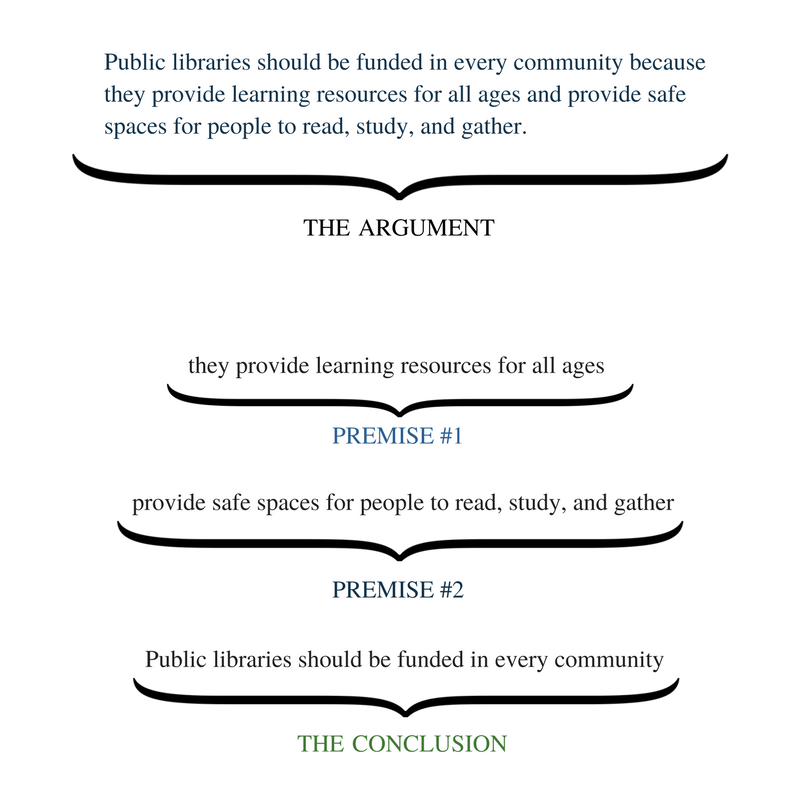
Recognizing arguments is essential to analysis and critical thinking; if you cannot distinguish between the details (the support) of a piece of writing and what those details are there to support (the argument), you will likely misunderstand what you are reading. Additionally, studying how others make arguments can help you learn how to effectively create your own.
What Are Argument Indicators?
While mapping an argument in standard argument form can be a good way to figure out and formulate a thesis, identifying arguments by other writers is also important. The best way to identify an argument is to ask whether a claim exists (in statement form) that a writer justifies by reasons (also in statement form). Other identifying markers of arguments are key words or phrases that are premise indicators or conclusion indicators. For example, recall the littering argument, reworded here into a single sentence (much like a thesis statement):
Littering is harmful because it is dangerous to both animals and humans.
The word “because” here is a premise indicator. That is, “because” indicates that what follows is a reason for thinking that littering is bad. Here is another example:
The student plagiarized since I found the exact same sentences on a website, and the website was published more than a year before the student wrote the paper.
In this example, the word “since” is a premise indicator because what follows is a statement that is clearly intended to be a reason for thinking that the student plagiarized (i.e., a premise). Notice that in these two cases, the premise indicators “because” and “since” are interchangeable: “because” could be used in place of “since” or “since” in the place of “because,” and the meaning of the sentences would have been the same.
Figure 3.3 “Common Premise Indicators”
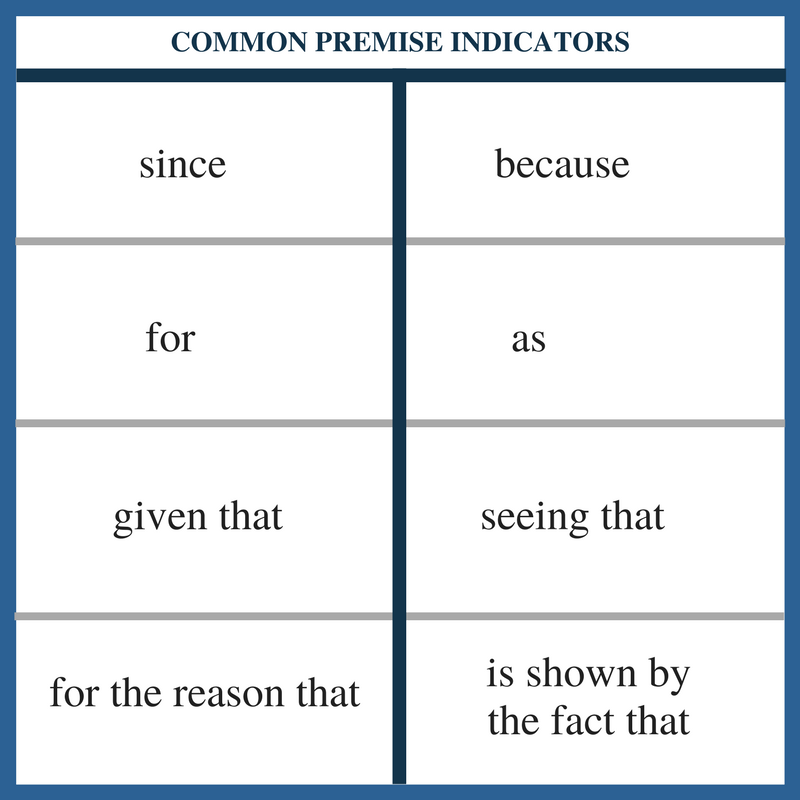
In addition to premise indicators, there are also conclusion indicators. Conclusion indicators mark that what follows is the conclusion of an argument. For example,
Bob-the-arsonist has been dead for a year, so Bob-the-arsonist didn’t set the fire at the East Lansing Starbucks last week.
In this example, the word “so” is a conclusion indicator because what follows it is a statement that someone is trying to establish as true (i.e., a conclusion). Here is another example of a conclusion indicator:
A poll administered by Gallup (a respected polling company) showed candidate X to be substantially behind candidate Y with only a week left before the vote; therefore, candidate Y will probably not win the election.
In this example, the word “therefore” is a conclusion indicator because what follows it is a statement that someone is trying to establish as true (i.e., a conclusion). As before, in both of these cases, the conclusion indicators “so” and “therefore” are interchangeable: “So” could be used in place of “therefore” or “therefore” in the place of “so,” and the meaning of the sentences would have been the same.
Figure 3.4 “Common Conclusion Indicators”
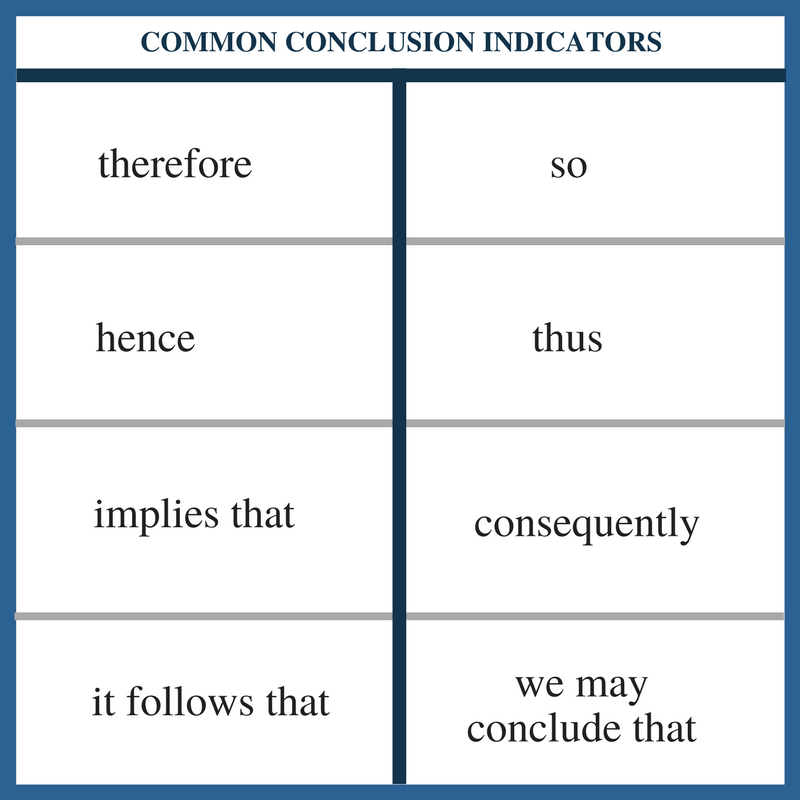
Exercise 2
Which of the following are arguments? If it is an argument, identify the conclusion (claim) of the argument. If it is not an argument, explain why not. Remember to look for the qualifying features of an argument: (1) It is a statement or series of statements, (2) it states a claim (a conclusion), and (3) it has at least one premise (reason for the claim).
- The woman with the hat is not a witch since witches have long noses, and she doesn’t have a long nose.
- I have been wrangling cattle since before you were old enough to tie your own shoes.
- Albert is angry with me, so he probably won’t be willing to help me wash the dishes.
- First, I washed the dishes, and then I dried them.
- If the road weren’t icy, the car wouldn’t have slid off the turn.
- Marvin isn’t a fireman and isn’t a fisherman, either.
- Are you seeing the rhinoceros over there? It’s huge!
- Obesity has become a problem in the US because obesity rates have risen over the past four decades.
- Bob showed me a graph with rising obesity rates, and I was very surprised to see how much they had risen.
- Marvin isn’t a fireman because Marvin is a Greyhound, which is a type of dog, and dogs can’t be firemen.
- What Susie told you is not the actual reason she missed her flight to Denver.
- Carol likely forgot to lock her door this morning because she was distracted by a clown riding a unicycle while singing Lynyrd Skynyrd’s “Simple Man.”
- No one who has ever gotten frostbite while climbing K2 has survived to tell about it; therefore, no one ever will.
What Constitutes Support?
To ensure that your argument is sound—that the premises for your conclusion are true—you must establish support. The burden of proof, to borrow language from law, is on the one making an argument, not on the recipient of an argument. If you wish to assert a claim, you must then also support it, and this support must be relevant, logical, and sufficient.
It is important to use the right kind of evidence, to use it effectively, and to have an appropriate amount of it.
- If, for example, your philosophy professor did not like that you used a survey of public opinion as your primary evidence in an ethics paper, you most likely used material that was not relevant to your topic. Rather, you should find out what philosophers count as good evidence. Different fields of study involve types of evidence based on relevance to those fields.
- If your professor has put question marks by your thesis or has written, “It does not follow,” you likely have problems with logic. Make sure it is clear how the parts of your argument logically fit together.
- If your instructor has told you that you need more analysis, suggested that you are “just listing” points or giving a “laundry list,” you likely have not included enough explanation for how a point connects to and supports your argument, which is another problem with logic, this time related to the warrants of your argument. You need to fully incorporate evidence into your argument. (See more on warrants immediately below.)
- If you see comments like “for example?,” “proof?,” “go deeper,” or “expand,” you may need more evidence. In other words, the evidence you have is not yet sufficient. One or two pieces of evidence will not be enough to prove your argument. Similarly, multiple pieces of evidence that aren’t developed thoroughly would also be flawed, also insufficient. Would a lawyer go to trial with only one piece of evidence? No, the lawyer would want to have as much evidence as possible from a variety of sources to make a viable case. Similarly, a lawyer would fully develop evidence for a claim using explanation, facts, statistics, stories, experiences, research, details, and the like.
You will find more information about the different types of evidence, how to find them, and what makes them credible in Chapter 6, “Research.” Logic will be covered later on in this chapter.
What Is the Warrant?
Above all, connect the evidence to the argument. This connection is the warrant. Evidence is not self-evident. In other words, after introducing evidence into your writing, you must demonstrate why and how this evidence supports your argument. You must explain the significance of the evidence and its function in your paper. What turns a fact or piece of information into evidence is the connection it has with a larger claim or argument: Evidence is always evidence for or against something, and you have to make that link clear.
Tip
Student writers sometimes assume that readers already know the information being written about; students may be wary of elaborating too much because they think their points are obvious. But remember, readers are not mind readers: Although they may be familiar with many of the ideas discussed, they don’t know what writers want to do with those ideas unless they indicate that through explanations, organization, and transitions. Thus, when you write, be sure to explain the connections you made in your mind when you chose your evidence, decided where to place it in your paper, and drew conclusions based on it.
What Is a Counterargument?
Remember that arguments are multi-sided. As you brainstorm and prepare to present your idea and your support for it, consider other sides of the issue. These other sides are counterarguments. Make a list of counterarguments as you work through the writing process, and use them to build your case – to widen your idea to include a valid counterargument, to explain how a counterargument might be defeated, to illustrate how a counterargument may not withstand the scrutiny your research has uncovered, and/or to show that you are aware of and have taken into account other possibilities.
For example, you might choose the issue of declawing cats and set up your search with the question should I have my indoor cat declawed? Your research, interviews, surveys, personal experiences might yield several angles on this question: Yes, it will save your furniture and your arms and ankles. No, it causes psychological issues for the cat. No, if the cat should get outside, he will be without defense. As a writer, be prepared to address alternate arguments and to include them to the extent that it will illustrate your reasoning.
Almost anything claimed in a paper can be refuted or challenged. Opposing points of view and arguments exist in every debate. It is smart to anticipate possible objections to your arguments – and to do so will make your arguments stronger. Another term for a counterargument is antithesis (i.e., the opposition to a thesis). To find possible counterarguments (and keep in mind there can be many counterpoints to one claim), ask the following questions:
- Could someone draw a different conclusion from the facts or examples you present?
- Could a reader question any of your assumptions or claims?
- Could a reader offer a different explanation of an issue?
- Is there any evidence out there that could weaken your position?
If the answer to any of these questions is yes, the next set of questions can help you respond to these potential objections:
Is it possible to concede the point of the opposition, but then challenge that point’s importance/usefulness?
- Can you offer an explanation of why a reader should question a piece of evidence or consider a different point of view?
- Can you explain how your position responds to any contradicting evidence?
- Can you put forward a different interpretation of evidence?
It may not seem likely at first, but clearly recognizing and addressing different sides of the argument, the ones that are not your own, can make your argument and paper stronger. By addressing the antithesis of your argument essay, you are showing your readers that you have carefully considered the issue and accept that there are often other ways to view the same thing.
You can use signal phrases in your paper to alert readers that you are about to present an objection. Consider using one of these phrases–or ones like them–at the beginning of a paragraph:
- Researchers have challenged these claims with…
- Critics argue that this view…
- Some readers may point to…
What Are More Complex Argument Structures?
So far you have seen that an argument consists of a conclusion and a premise (typically more than one). However, often arguments and explanations have a more complex structure than just a few premises that directly support the conclusion. For example, consider the following argument:
No one living in Pompeii could have survived the eruption of Mt. Vesuvius. The reason is simple: The lava was flowing too fast, and there was nowhere to go to escape it in time. Therefore, this account of the eruption, which claims to have been written by an eyewitness living in Pompeii, was not actually written by an eyewitness.
The main conclusion of this argument—the statement that depends on other statements as evidence but doesn’t itself provide any evidence for other statements—is
A. This account of the eruption of Mt. Vesuvius was not actually written by an eyewitness.
However, the argument’s structure is more complex than simply having a couple of premises that provide evidence directly for the conclusion. Rather, some statements provide evidence directly for the main conclusion, but some premise statements support other premise statements which then support the conclusion.
To determine the structure of an argument, you must determine which statements support which, using premise and conclusion indicators to help. For example, the passage above contains the phrase, “the reason is…” which is a premise indicator, and it also contains the conclusion indicator, “therefore.” That conclusion indicator helps identify the main conclusion, but the more important element to see is that statement A does not itself provide evidence or support for any of the other statements in the argument, which is the clearest reason statement A is the main conclusion of the argument. The next questions to answer are these: Which statement most directly supports A? What most directly supports A is
B. No one living in Pompeii could have survived the eruption of Mt. Vesuvius.
However, there is also a reason offered in support of B. That reason is the following:
C. The lava from Mt. Vesuvius was flowing too fast, and there was nowhere for someone living in Pompeii to go to escape it in time.
So the main conclusion (A) is directly supported by B, and B is supported by C. Since B acts as a premise for the main conclusion but is also itself the conclusion of further premises, B is classified as an intermediate conclusion. What you should recognize here is that one and the same statement can act as both a premise and a conclusion. Statement B is a premise that supports the main conclusion (A), but it is also itself a conclusion that follows from C. Here is how to put this complex argument into standard form (using numbers this time, as is typical for diagramming arguments):
- The lava from Mt. Vesuvius was flowing too fast, and there was nowhere for someone living in Pompeii to go to escape it in time.
- Therefore, no one living in Pompeii could have survived the eruption of Mt. Vesuvius. (from 1)
- Therefore, this account of the eruption of Mt. Vesuvius was not actually written by an eyewitness. (from 2)
Notice that at the end of statement 2 is a written indicator in parentheses (from 1), and, likewise, at the end of statement 3 is another indicator (from 2). From 1 is a shorthand way of saying, “this statement follows logically from statement 1.” Use this convention as a way to keep track of an argument’s structure. It may also help to think about the structure of an argument spatially, as the figure below shows:
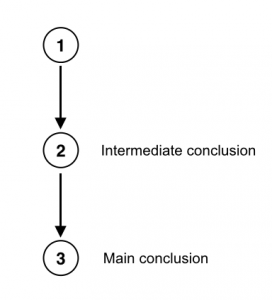
The main argument here (from 2 to 3) contains a subargument, in this case, the argument from 1 (a premise) to 2 (the intermediate conclusion). A subargument, as the term suggests, is a part of an argument that provides indirect support for the main argument. The main argument is simply the argument whose conclusion is the main conclusion.
Another type of structure that arguments can have is when two or more premises provide direct but independent support for the conclusion. Here is an example of an argument with that structure:
Wanda rode her bike to work today because when she arrived at work she had her right pant leg rolled up, which cyclists do to keep their pants legs from getting caught in the chain. Moreover, our co-worker, Bob, who works in accounting, saw her riding towards work at 7:45 a.m.
The conclusion of this argument is “Wanda rode her bike to work today”; two premises provide independent support for it: the fact that Wanda had her pant leg cuffed and the fact that Bob saw her riding her bike. Here is the argument in standard form:
- Wanda arrived at work with her right pant leg rolled up.
- Cyclists often roll up their right pant leg.
- Bob saw Wanda riding her bike towards work at 7:45.
- Therefore, Wanda rode her bike to work today. (from 1-2, 3 independently)
Again, notice that next to statement 4 of the argument is an indicator of how each part of the argument relates to the main conclusion. In this case, to avoid any ambiguity, you can see that the support for the conclusion comes independently from statements 1 and 2, on the one hand, and from statement 3, on the other hand. It is important to point out that an argument or subargument can be supported by one or more premises, the case in this argument because the main conclusion (4) is supported jointly by 1 and 2, and singly by 3. As before, we can represent the structure of this argument spatially, as the figure below shows:
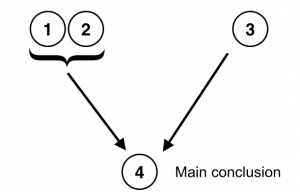
There are endless argument structures that can be generated from a few simple patterns. At this point, it is important to understand that arguments can have different structures and that some arguments will be more complex than others. Determining the structure of complex arguments is a skill that takes some time to master, rather like simplifying equations in math. Even so, it may help to remember that any argument structure ultimately traces back to some combination of premises, intermediate arguments, and a main conclusion.
Exercise 3
Write the following arguments in standard form. If any arguments are complex, show how each complex argument is structured using a diagram like those shown just above.
1. There is nothing wrong with prostitution because there is nothing wrong with consensual sexual and economic interactions between adults. Moreover, there is no difference between a man who goes on a blind date with a woman, buys her dinner and then has sex with her and a man who simply pays a woman for sex, which is another reason there is nothing wrong with prostitution.
2. Prostitution is wrong because it involves women who have typically been sexually abused as children. Proof that these women have been abused comes from multiple surveys done with female prostitutes that show a high percentage of self-reported sexual abuse as children.
3. Someone was in this cabin recently because warm water was in the tea kettle and wood was still smoldering in the fireplace. However, the person couldn’t have been Tim because Tim has been with me the whole time. Therefore, someone else must be in these woods.
4. Someone can be blind and yet run in the Olympic Games since Marla Runyan did it at the 2000 Sydney Olympics.
5. The train was late because it had to take a longer, alternate route seeing as the bridge was out.
6. Israel is not safe if Iran gets nuclear missiles because Iran has threatened multiple times to destroy Israel, and if Iran had nuclear missiles, it would be able to carry out this threat. Furthermore, since Iran has been developing enriched uranium, it has the key component needed for nuclear weapons; every other part of the process of building a nuclear weapon is simple compared to that. Therefore, Israel is not safe.
7. Since all professional hockey players are missing front teeth, and Martin is a professional hockey player, it follows that Martin is missing front teeth. Because almost all professional athletes who are missing their front teeth have false teeth, it follows that Martin probably has false teeth.
8. Anyone who eats the crab rangoon at China Food restaurant will probably have stomach troubles afterward. It has happened to me every time; thus, it will probably happen to other people as well. Since Bob ate the crab rangoon at China Food restaurant, he will probably have stomach troubles afterward.
9. Lucky and Caroline like to go for runs in the afternoon in Hyde Park. Because Lucky never runs alone, any time Albert is running, Caroline must also be running. Albert looks like he has just run (since he is panting hard), so it follows that Caroline must have run, too.
10. Just because Linda’s prints were on the gun that killed Terry and the gun was registered to Linda, it doesn’t mean that Linda killed Terry since Linda’s prints would certainly be on her own gun, and someone else could have stolen her gun and used it to kill Terry.
Key Takeaways: Components of Vocabulary and Argument
- Conclusion—a claim that is asserted as true. One part of an argument.
- Premise—a reason behind a conclusion. The other part of an argument. Most conclusions have more than one premise.
- Statement—a declarative sentence that can be evaluated as true or false. The parts of an argument, premises and the conclusion, should be statements.
- Standard Argument Form—a numbered breakdown of the parts of an argument (conclusion and all premises).
- Premise Indicators—terms that signal that a premise, or reason, is coming.
- Conclusion Indicator—terms that signal that a conclusion, or claim, is coming.
- Support—anything used as proof or reasoning for an argument. This includes evidence, experience, and logic.
- Warrant—the connection made between the support and the reasons of an argument.
- Counterargument—an opposing argument to the one you make. An argument can have multiple counterarguments.
- Complex Arguments–these are formed by more than individual premises that point to a conclusion. Complex arguments may have layers to them, including an intermediate argument that may act as both a conclusion (with its own premises) and a premise (for the main conclusion).

